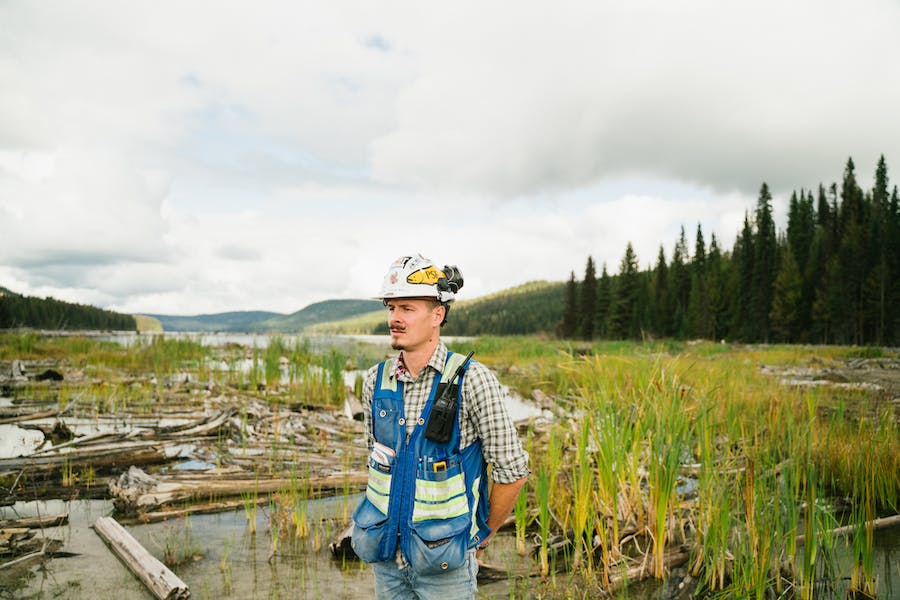From towering skyscrapers to complex water treatment plants, civil engineers create the infrastructure that enables modern society to thrive. Yet, as development continues apace, preserving nature’s balance has become an equal priority. So, what exactly is the difference between civil and environmental engineering?
This is where environmental engineers step in with solutions to harmonize human progress and ecological health. Though their aims often overlap, the focus of civil and environmental engineering can differ.
In this article, we’ll embark on a journey to explore and provide insights into the unique domains of these engineering branches.

Difference Between Civil and Environmental Engineering
Civil engineering is the discipline that focuses on the design, construction, and maintenance of infrastructure and the built environment. It deals with large-scale structures and systems that are essential for modern life.
Environmental engineering, on the other hand, is concerned with protecting and preserving the natural environment. It deals with designing systems and processes that address environmental issues such as water and air pollution, waste management, and sustainable practices.
Subfields within civil engineering include structural engineering, transportation engineering, geotechnical engineering, and more. Subfields within environmental engineering encompass water resources engineering, air quality management, environmental health, and more.
Core Differences Between Civil and Environmental Engineering
Primary focus of civil engineering
Civil engineering primarily focuses on the design, construction, and maintenance of physical infrastructure that forms the foundation of our modern society. The key areas of concentration within civil engineering are:
- Structural engineering – Civil engineers in this field are responsible for designing and ensuring the safety and stability of structures like buildings, bridges, and dams. They work to withstand various loads, including gravity, wind, and earthquakes.
- Transportation engineering – This subfield revolves around planning and designing transportation systems, including highways, railways, airports, and transit systems. Civil engineers in this area seek to optimize the movement of people and goods.
- Geotechnical engineering – Geotechnical Engineers deal with the behavior of the Earth’s materials. They evaluate soil and rock properties to provide the foundations for structures, as well as solutions for retaining walls and slopes.
- Construction engineering and management – These professionals oversee construction projects, ensuring they are executed efficiently, on time, and within budget. They manage resources, schedules, and labor.
Civil Engineering, thus, is deeply ingrained in creating the physical infrastructure that sustains human civilization. It focuses on stability, functionality, and safety.
Primary focus of environmental engineering
Environmental engineering primarily concentrates on addressing environmental challenges and protecting the natural world. Key areas within Environmental Engineering include:
- Water resources engineering – Environmental engineers in this area work to provide clean and safe drinking water, manage stormwater, and treat wastewater. They also engage in water conservation and the protection of aquatic ecosystems.
- Air quality management – Environmental engineers specializing in air quality management focus on monitoring and controlling air pollution. They develop strategies to reduce emissions and improve air quality to protect human health and the environment.
- Waste management – Environmental engineers in waste management are responsible for designing and implementing systems to handle various types of waste, from solid waste in landfills to hazardous waste treatment.
- Environmental health – This subfield addresses public health concerns related to environmental factors, including air and water quality, food safety, and disease control. Environmental health engineers work to ensure that communities have access to safe and healthy environments.

Overlapping Areas Between Civil and Environmental Engineering
Environmental considerations in civil engineering
As the importance of environmental sustainability grows, civil engineering has increasingly integrated environmental considerations into its projects. The realization that the built environment profoundly impacts the natural world has led to the inclusion of ecological factors in civil engineering designs.
This includes preserving water quality, protecting wildlife habitats, and minimizing erosion. Integrating these environmental concerns ensures that engineering projects at Cypress Environment & Infrastructure are not just functional but also environmentally responsible.
How civil engineering applies to environmental concerns
Civil engineering plays a pivotal role in addressing environmental challenges. This extends beyond the minimization of ecological impact and encompasses creating solutions for environmental issues.
Civil engineers work on projects related to sustainable infrastructure. This includes developing renewable energy sources, improving public transportation to reduce emissions, and designing stormwater management systems that prevent pollution of natural water bodies.
In essence, civil engineering contributes to environmental preservation and restoration. It does this by applying its expertise to find innovative eco-friendly and sustainable solutions.
The areas where civil and environmental engineering overlap highlight the synergistic relationship between the two disciplines. Working together, they have the capacity to create a more sustainable future.

Conclusion
While civil and environmental engineering share the broader goal of developing a sustainable built environment, their focuses differ. Civil engineering deals primarily with infrastructure and development projects, while environmental engineering concentrates on protecting ecological systems.
However, as environmental issues become more pressing, the two disciplines are overlapping more to find integrated solutions. Understanding the distinctions between civil and environmental engineering provides insights into their specialized roles in building a sustainable future.
